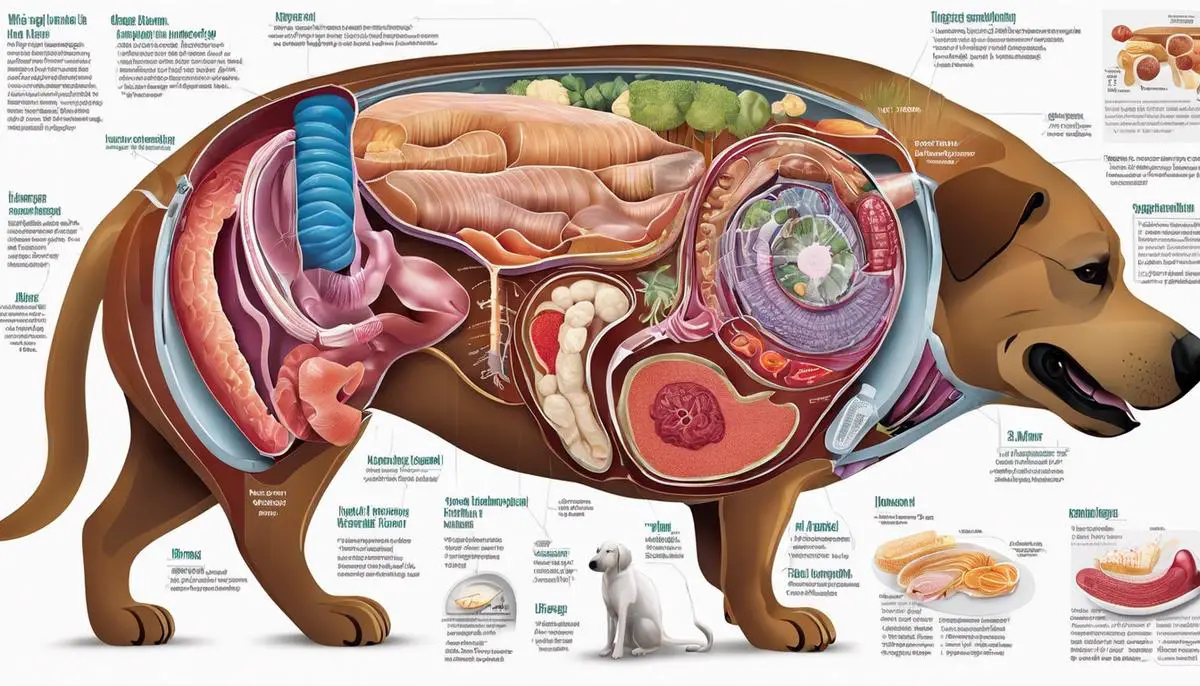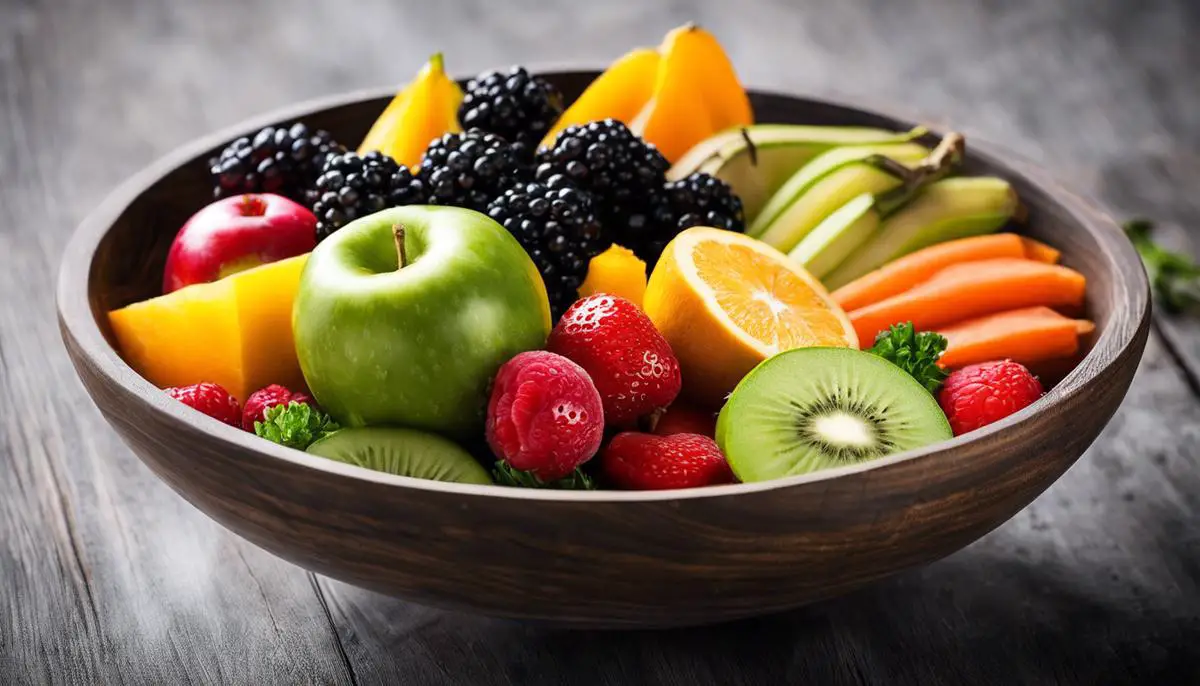When it comes to the health and well-being of our furry friends, understanding their dietary needs is of utmost importance. Endearing as they may be, our canine companions have a distinct digestive system that differs greatly from ours, hence not all foods we enjoy are suitable for them. Key among these are apples, a common fruit that we often take for granted. This piece will delve into understanding a dog’s digestive system, analyse the composition of apples – focusing specifically on the skin, and provide a comprehensive list of safe and unsafe foods for dogs, together with guidelines on the proper introduction of these foods into their diet.
Understanding Dogs’ Digestive System
Understanding Your Furry Friend: Comparing a Dog’s Digestive System to Humans
Every loving pet parent strives to ensure the best for their furry friends, and that involves knowing a thing or two about their health. How many pet parents among us have ever paused to wonder how a dog’s digestive system differs from humans’? It’s worth noting that while we may shower them with love and treat them like human babies, their digestive process is uniquely canine.
Starting off at the mouth, dogs have a more straightforward approach to their food as compared to humans. Blessed with a far stronger jaw motion and teeth designed to tear and crunch, dogs are good at wolfing down their food, often with little or no chewing. Unlike us humans who have to chew our food thoroughly to kick off the digestion process, our four-legged friends get this process going much more rapidly.
Next, let’s venture into the stomach. Dogs’ stomachs are well-equipped to handle a more rigorous diet, distinct from humans’ delicate, balanced meal plans. Their stomachs produce stronger acids that could upset a human stomach. This ability enables dogs to digest a wide array of foods, including raw meats that would otherwise be harmful to humans. Think of it this way, your pooch’s stomach is somewhat like a superhero’s shield, protecting them from harmful bacteria.
The intriguing differences continue even in the intestines. A dog’s intestines are shorter than humans’, about two-thirds of the size in relation to body length. This design strategy in the animal kingdom is logical – carnivores have shorter intestines to allow quicker digestion of meats and fats, while herbivores like us humans have longer intestines that allow time for the breakdown of complex carbohydrates.
The liver’s functionality is somewhat similar across species, yet the liver in dogs carries a unique character. It’s incredibly effective in regenerating itself and can function normally with up to 80% of it removed! Dogs’ livers also lack an enzyme that human livers have, which assists in breaking down alcohol. This is one of the reasons alcohol proves hazardous to dogs.
Moving towards the end of the journey, dogs’ large intestines, like in most creatures, are the last stop for water and electrolyte absorption. It’s shorter in dogs than in humans, meaning dogs have a faster total transit time for food. Simply put, their system efficiently processes food and dumps their waste much quicker than us.
Ultimately, understanding these differences can enhance the relationship between pet parents and their beloved canines. With knowledge of their digestive process, we can make informed decisions about feeding our pooch and ensure that every belly rub is a reward for a well-functioning, happy tummy. Plus, it’s another fascinating insight into the lives of our four-legged friends, reminding us of their unique needs and our responsibility to cater to them. Happy pet parenting!

Analyzing Apples
Apple Skin: A Nutritional Powerhouse
Close your eyes and picture that inviting bowl of shiny, crisp apples on your kitchen counter. Now, imagine your family biting into those apples, their faces lighting up with the tangy-sweet burst of flavors. Sounds enticing, right? But wait! Are we missing something? The apple skin!
Often overlooked, apple skin is actually a tiny repository of health and nutrition. It’s no secret that apples are great for us – but did you know that about two-thirds of the fiber and antioxidants are found in the skin? Let’s unravel the mystery behind what makes the apple skin a superfood and why we shouldn’t be discarding it!
1. Fiber
The skin of the apple is incredibly rich in dietary fiber, particularly soluble fiber, which aids in digestion and helps to reduce bad cholesterol. In fact, one medium apple, with skin, provides approximately 4.4 grams of fiber. This could be a tasty way to add more fiber to your family’s diet.
2. Vitamins
Apple skin contains a good amount of Vitamin C and A – essential for immune function, maintaining skin health and supporting eye health. The Vitamin C present is also a potent antioxidant that helps protect our body’s cells from damage.
3. Antioxidants
The skin of an apple is packed with several antioxidants, including quercetin, which promotes brain and lung health; epicatechin, which is good for heart health; and the flavonoid phloridzin, which is exclusively found in apples and is particularly beneficial for women’s bone health.
4. Potassium
Apple skins offer a decent amount of potassium, a key mineral that aids in nerve signal transmission, muscle function and maintaining a healthy balance of fluids in the body.
5. Polyphenols
These compounds, largely present in apple skin, have been linked to numerous health benefits, including reduced risk of heart disease, prevention of asthma, and improved digestion.
The takeaway? Keep the skin on for added nutrition! The next time you reach for an apple, remember that giving it a good, thorough wash is a whole lot better than peeling away its nutritious skin. Making smaller lifestyle changes can often contribute significantly to our family’s health – and keeping the apple peel on is undoubtedly one of them!
Keep in mind, while our bodies can easily process all these beneficial components found in apple skin, our furry friends might not be as accommodating due to their different digestive system. Just as you consider your family’s nutrition, it’s equally important to consider the unique dietary requirements of your pets, like dogs. Now, go enjoy that delicious, nutritious apple – skin and all!

Safe and Unsafe Foods for Dogs
Moving from the broader look at a dog’s digestive system, let’s narrow our focus a bit. Dogs not only possess a robust and somewhat versatile system, but they also exhibit noticeable preferences when it comes to what goes in. Given this, it’s critical that we ponder which fruits and veggies are safe and beneficial to our furry friends.
First up are apples, a popular snack for both humans and dogs. Because they’re jam-packed with minerals, vitamins, and antioxidants, apples serve as a fruitful supplement to a dog’s diet. As beneficial as they are, make sure to remove the core and seeds, which can be harmful. The body of the apple and the skin, once washed, is the best part to offer to our pooch pals!
In addition to apples, carrots are highly beneficial for dogs. Rich in Vitamin A and fiber, they contribute positively to the immune system and eye health. Another advantage to carrots? They act as a natural tooth cleaner, making them an excellent treat for any dog.
Bananas can be a significant addition to a dog’s diet, due to their high potassium content and richness in vitamins C and B6. In moderation, they can help maintain a dog’s heart and kidney health. However, due to the high sugar content, they should serve as an occasional dessert, and not a staple in a dog’s diet.
In the world of vegetables, peas, both green and snow peas, come dog-approved and packed with iron, potassium, and vitamin A and B. However, moderation is the key in this case too.
Last but certainly not the least, is the wonder vegetable, pumpkin. This humble orange superstar is a fantastic source of fiber, aiding in digestion and weight maintenance. The beta carotene and antioxidants present in it contribute to overall health and wellness of dogs abundantly.
While these are all great options, remember that every dog is unique, and what suits one might not suit another. Their breed, size, activity level, and overall health determine a dog’s dietary requirements. So, before introducing new fruits and vegetables into their meals, a quick chat with the vet might be helpful. A bite-sized approach is best when introducing new foods. Start small, monitor, and then slowly increase the portion.
As in life, balance is the key here too. Predominantly, a dog’s diet should be made up of high-quality dog food that’s formulated to meet all of their nutritional needs. Fruits and veggies are great supplements but shouldn’t replace their main meals.
A nutritionally balanced diet, plenty of playtime and heaps of love are the ingredients for a happy and healthy life for our four-legged companions. After all, a well-nourished dog is not just a pet but a joyful, energetic addition to our family unit. An integral part of parenting a pet is understanding their dietary needs, and with this information, it becomes less of a daunting task and more of an enriching journey.

Through appreciating the intricacies of a dog’s digestive system, closely examining the properties of apples and their skin, and having a clear grasp of which fruits and vegetables are safe or harmful, we can ensure optimal health for our dogs. This knowledge not only fosters a healthier lifestyle for our pets, but it also deepens our bond with them as we continually strive to provide the best care. Remember, introducing new foods to a dog’s diet should always be done gradually and with close observation. Whenever in doubt, the best course of action is always to consult a trusted veterinarian. It is indeed incumbent upon us, as responsible pet owners, to be discerning about the foods our dogs consume as their health and happiness heavily lie on our hands.
